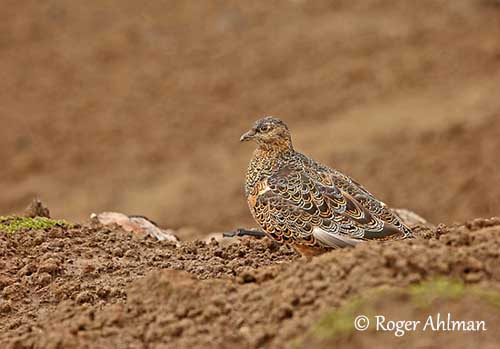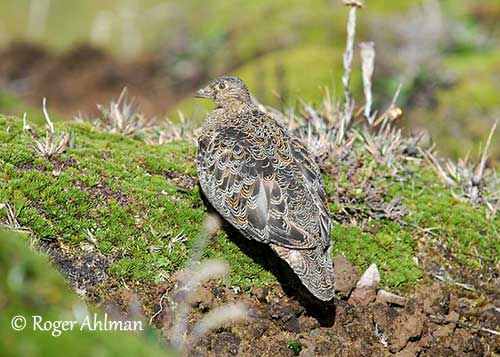
Fr: Attagis de Gay
Ang: Rufous-bellied Seedsnipe
All: Rotbauch-Höhenläufer
Esp: Agachona Grande
Ita: Tinocoride pettorossiccio
Nd: Andeskwartelsnip
Sd: rostbukig frösnäppa
Photographers:
Roger Ahlman
Pbase Galleries Peru and Ecuador
Didier Buysse
Vision d’Oiseaux
Text by Nicole Bouglouan
Sources:
HANDBOOK OF THE BIRDS OF THE WORLD Vol 3 by Josep del Hoyo-Andrew Elliott-Jordi Sargatal - Lynx Edicions - ISBN : 8487334202
SHOREBIRDS by Peter Hayman, John Marchant and Tony Prater – Christopher Helm – 1986 – ISBN: 0747014035
L’ENCYCLOPEDIE MONDIALE DES OISEAUX - Dr Christopher M. Perrins - BORDAS - ISBN: 2040185607
Neotropical Birds – Cornell Lab of Ornithology
Wikipedia, the free encyclopaedia
Wikipedia, la enciclopedia libre
Thinocoridae Family
Summary cards
Rufous-bellied Seedsnipe
Attagis gayi
Charadriiformes Order – Thinocoridae Family
INTRODUCTION:
Endemic to the Neotropical regions, the Rufous-bellied Seedsnipe and the three other species of the family Thinocoridae differ strongly from Charadriiform birds. However, it is fairly similar to a sandgrouse (Pteroclididae) itself often considered close to Charadriiformes.
The Rufous-bellied Seedsnipe frequents remote habitats usually little used by humans. The species is present in its habitat at all seasons, living near the glaciers in cold weather and snow, often in flocks during the dry season, and mostly in pairs during the rainfalls.
This Andean species is generally seen at high elevations of at least 1000 metres and much higher in some areas. It frequents well-watered places fed by melting snow.
In spite of its resemblance to gallinaceous birds, the Rufous-bellied Seedsnipe resembles shorebirds through several anatomical characters.

DESCRIPTION OF THE BIRD:
Biometrics:
Length: 27-30 cm
Weight: 300-400 g
The Rufous-bellied Seedsnipe is the largest of the four members of the family Thinocoridae. It has short legs and long-pointed wings.
The adult of nominate race in the palest race. It has cryptic plumage overall, with rufous-brown mottling on the upperparts, and extensively fringed and vermiculated feathers with narrow whitish or rufous bars, giving conspicuous scaled effect. The markings are broader and more rufous on the wing-coverts. The flight feathers are brown with rufous fringes, and the tail is brownish with buff-olive barring.
The underparts are pale pinkish cinnamon or washed cinnamon-brown to chestnut. There is a darker breast band formed by narrow, irregular dark brown crescents. The belly feathers may show broad paler fringes involving mottled pattern. Underwing-coverts and axillaries are uniformly cinnamon.
The bill is greyish-brown. The eyes are pale brown, surrounded by whitish eyering. Legs and feet are pale yellow.
Male and female are similar.
The juvenile resembles adults, but the pattern of the upperparts shows finer mottling.
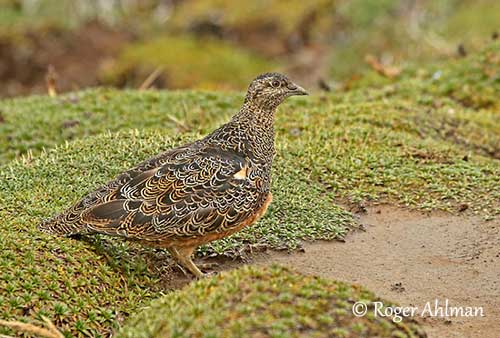
SUBSPECIES AND RANGE:
The Rufous-bellied Seedsnipe has three recognized subspecies.
A.g. latreillii or Ecuadorian Seedsnipe (displayed) occurs in NC Ecuador from Pichincha to NW Morona-Santiago. This race has deep cinnamon-rufous lower underparts and more strongly scalloped breast.
A.g. simonsi (displayed in flight) is found in C Peru (Lima), through N Chile and W Bolivia to NW Argentina (Jujuy). This one has mostly pinkish-cinnamon underparts.
A.g. gayi (described above but not displayed) or Rufous-bellied Seedsnipe, is found in the Andes of Chile and Argentina to Tierra del Fuego. The nominate race is similar to “simonsi” but overall paler above, with broader vermiculations.
HABITAT:
The Rufous-bellied Seedsnipe is often seen around the snow-line up to 4000/5500 metres of elevation, but in the south, it occurs as low as 2000 metres, and even 1000 metres in extreme south of the range.
It frequents rocky slopes and generally alpine terrain in the Andes. However, it also frequents grasslands and low-vegetated areas where it forages and feeds. In Ecuador, it is often recorded in highest páramos. It nests on barren slopes or among sparse vegetation.
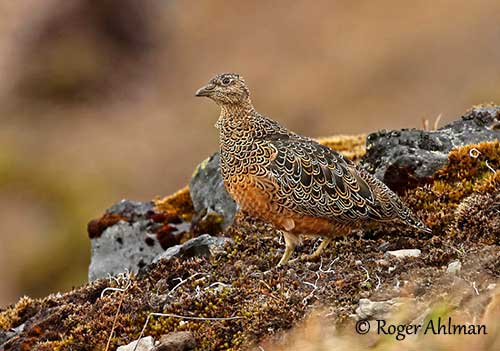
CALLS AND SONGS: SOUNDS BY XENO-CANTO
The Rufous-bellied Seedsnipe gives a rasping “tchaa” when flushed. It is very vocal in flight but also on the ground while running before to take off. It gives a loud, melodic “gly-gly-gly-gly…” or “culy-culy-culy…” and these sounds are also given as song throughout the morning. Several birds often call together in flight.
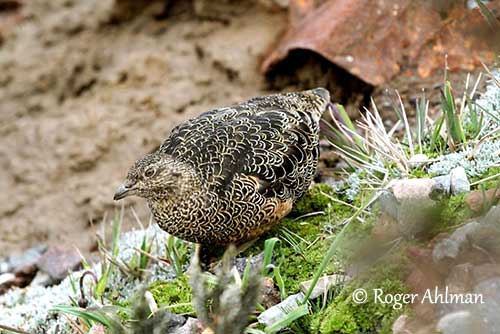
BEHAVIOUR IN THE WILD:
The Rufous-bellied Seedsnipe feeds on plant matter including thorny plants and others, and seeds. It takes small pieces of buds and small green leaves.
The bird forages and feeds by walking slowly, often in low, crouching posture, and performs quick snapping movements. The food items are swallowed whole.
It forages usually in areas with short vegetation including cushion-plants and low succulent plants, giving the bird some water. It has never been seen drinking.
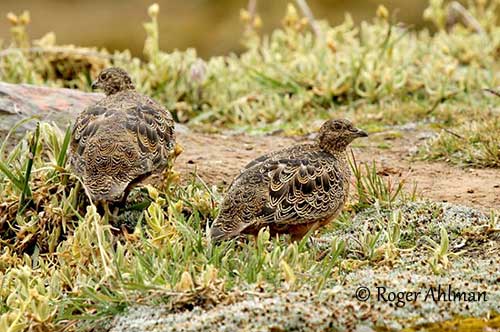
The breeding habits of the Rufous-bellied Seedsnipe are very poorly known, due to their remote and almost inaccessible habitat. However, they appear to be monogamous and territorial. The male spends much time perched on usual watch post. They often fight and chase each other. The males perform aerial nocturnal song flights at the beginning of the breeding season.
They roost on the ground in shallow scrapes where they lie. They often occur in pairs or in small groups, probably family parties. But small flocks of up to 80 individuals are often seen outside the breeding season.
The Rufous-bellied Seedsnipe is mainly resident in its range. Some short local movements may occur, but usually, the birds remain in their habitat, even in extreme weather conditions.
When flushed, the bird flies in low, rapid, zigzagging route. However, usually, the flight is more direct with rapid wingbeats.
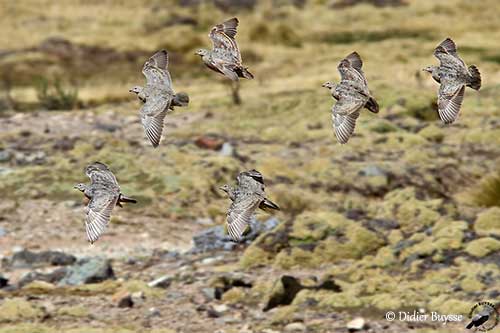
REPRODUCTION OF THIS SPECIES:
The egg laying occurs in September/October in Chile, whereas in Ecuador, young birds are found in October/early November.
The Rufous-bellied Seedsnipe nests solitary. The nest is a shallow depression, a scrape on the ground placed on barren slopes or among sparse vegetation, often close to stone or rock, or clump of grasses.
The female lays 3-4 strongly pear-shaped eggs cryptically coloured, usually olive-buff with brown and purplish-grey spots. The female incubates alone while the male spends much time near the nest, perched on its usual watch post. If threatened, it gives a warning call and both adults runs away until the end of the danger. But before to leave the nest, the female covers the eggs with earth and plant debris. She works quickly by using sideways kicks. However, nest materials are sometimes too scarce for good egg-covering. She may perform distraction displays by feigning an injury to attract the predator away from the nest-site.
The incubation period is unknown but probably lasts about 26-30 days. At hatching, the downy chicks have cryptic colour. They are precocial and able to walk and feed within one day.
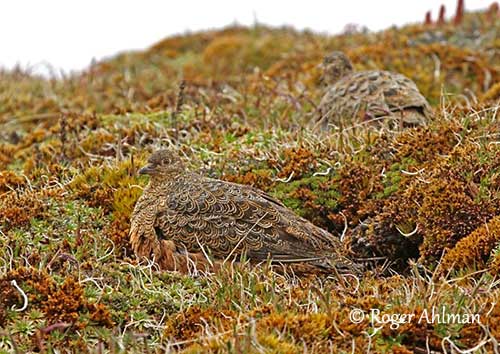
PROTECTION / THREATS / STATUS:
The Rufous-bellied Seedsnipe has poorly known status due to its inaccessible habitat. The species is usually fairly common near the snow-line, but it is strongly persecuted in some mining areas.
The Rufous-bellied Seedsnipe occurs in some protected parks and reserves and currently, this species is evaluated as Least Concern with stable population.
